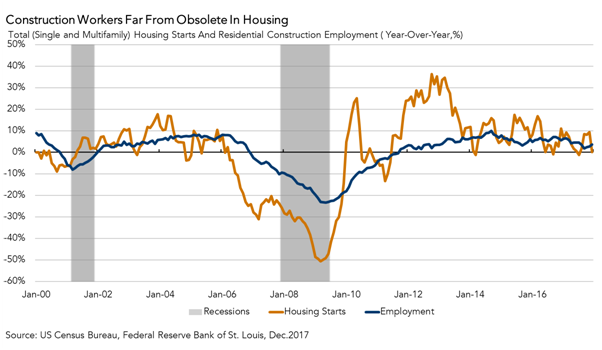The end of 2017 brought mixed news for housing starts, according to Thursday’s release of December 2017 housing starts data, which marked the first report on national housing data this year.
December 2017 Housing Starts
For the month of December 2017, the new residential construction report shows that:
- The number of permits issued, a leading indicator of housing starts, increased by 2.8 percent and housing starts decreased by 6.0 percent, compared with a year ago.
- The stock of housing units authorized to be built increased by 10.8 percent, and the number of housing units under construction increased by 4.8 percent on an annual basis.
- The number of completed homes, which is additional new net supply added to the housing stock, increased by 7.4 percent compared with a year ago.
"The annual increase in permits, in conjunction with the rise in employment, signals an upward trajectory for housing starts in 2018."
Housing Completions Signal a Turnaround for the Housing Market
As we analyze today’s housing starts data, it’s important to also consider the impact of construction labor on the velocity of new home construction. The employment situation report, released earlier this month, reported an increase of 8,200 residential construction jobs between November and December 2017. The number of residential construction jobs is now 3.6 percent higher than a year ago. The growth in residential construction jobs supports further improvement in the pace of home building, because building a home does not readily lend itself to outsourcing and automation.
However, builders broke ground on fewer homes this month in comparison to last. Despite this drop, the increase in completions signals some relief for the supply shortage. In addition, the annual increase in permits, in conjunction with the rise in employment, signals an upward trajectory for housing starts in 2018.

Chief Economist Analysis Highlights
- In December, the pace of housing starts, at 1.19 million units, declined 8.2 percent from the previous month. Based on the less volatile three-month moving average, the volume of total residential (single and multi-family) housing starts is 41,000 units lower than November 2017 and 1,000 units higher compared with a year ago.
- The lack of home building is a major reason that the market has been strained by a lack of inventory. Homebuilders continue to struggle to find skilled labor, especially framers, and buildable lots remain in short supply.
- Housing starts are an important source of future supply, and as we have previously discussed in our Real House Price Index (RHPI), the housing market is facing a supply constraint problem.
- Despite a fall in housing starts, the number of housing units completed in December 2017 increased 7.4 percent compared with a year ago, and 2.2 percent from November 2017.
- The annual amount of completions necessary just to keep pace with growing millennial demand and eliminate the housing shortage is estimated at around 1.5 million units (the housing starts historical average) – we are just falling short.
- Tight supply relative to increasing demand is driving nominal prices higher, yet home purchasing-power is also twice as high as it was in 2000.
- However, an estimated 1.15 million housing units were completed in 2017, an 8.7 percent increase from the 2016 figure of 1.06 million – a modest step toward producing enough housing to meet market demand.
What Insight Does Monthly Housing Starts Data Provide?
Housing starts data reports the number of housing units on which construction has been started in the month reported, providing a gauge of future real estate supply levels. The source of monthly housing starts data is the “New Residential Construction Report” issued by the U.S. Census Bureau jointly with the U.S. Department of Housing and Urban Development (HUD). The data is derived from surveys of homebuilders nationwide, and three metrics are provided: building permits, housing starts and housing completions. Building permits are a leading indicator of housing starts and completions, providing insight into the housing market and overall economic activity in upcoming months.
Housing starts reflect the commitment of home builders to new construction, as home builders usually don't start building a house unless they are confident it will sell upon completion. A change in the pace of housing starts tells us a lot about the future supply of homes available in the housing market. In addition, an increase in housing starts can lead to an increase in construction employment, which benefits the overall economy. Once the home is completed and sold, it generates revenue for the home builder and other related industries, and is added to the housing stock.



